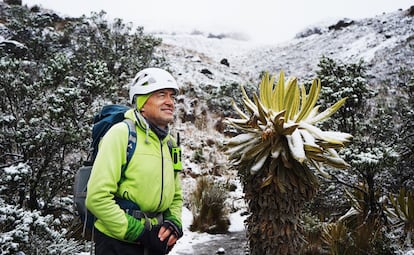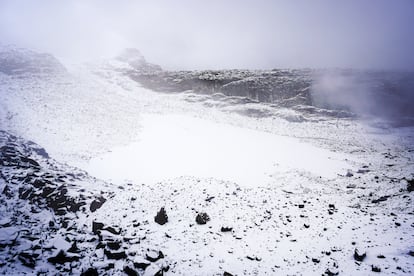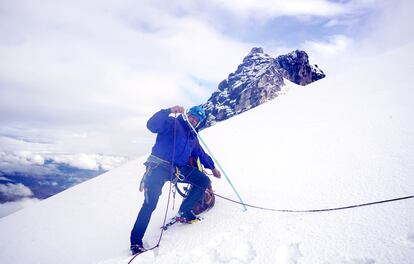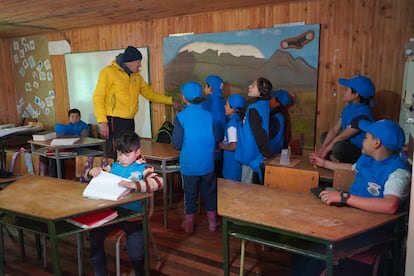The last warden of Colombia’s tropical glaciers
Jorge Luis Ceballos, his country’s sole glaciologist, will probably see his favorite ice mass disappear before he retires in three years


There is a man in Colombia who climbs 15,000-foot (4,500 meters) mountains every month without fail. On sunny and stormy days alike, he looks for beacons in the ice placed on previous trips where he measures the depth of snowpack. Jorge Luis Ceballos has been doing this for almost 20 years as the only glaciologist in Colombia, a country with some of few remaining tropical glaciers on the planet.
Ceballos is the pioneer of modern glaciology in Colombia and its last practitioner. He has worked for years in the scientific, political, diplomatic and even anthropological domains to study and preserve his country’s glaciers. He was the only scientist allowed by indigenous people to ascend the sacrosanct Cocuy glacier. He has negotiated with guerrillas to install weather stations in their territory, trained young mountain guides, and taught in rural schools so remote that some children have to travel two hours on horseback to get to class.
In late November, EL PAíS accompanied Ceballos, who is employed by Colombia’s Institute of Hydrology, Meteorology and Environmental Studies (IDEAM), on one of his monthly treks. We first climbed his favorite glacier – Conejeras – and then descended the mountain to the schools he regularly visits. The 59-year-old Ceballos seems unaffected by the thin air as he hikes, but admits to worrying about the Conejeras glacier on Santa Isabel mountain, which will probably disappear completely before he retires in three years. Why does he still go every month when he knows it’s hopeless? “If you had a friend with only six months to live,” said Ceballos, “You wouldn’t say, ‘Okay, I’ll come visit you in six months.’ No. You would visit him all the time during his final days. Well, that’s the way I feel about this glacier.”
When we hiked up Conejeras in November, the fatally ill patient seemed to have miraculously recovered. The entire mountain was covered in snow, and it was cold and foggy. The glacial ice seemed to stretch beyond the horizon. But it was all a mirage. Conejeras is one of Colombia’s most rapidly shrinking glaciers, having lost 90% of its mass since 1850. And the melting has accelerated alarmingly in the last few decades. Although he admits it’s true, it pains Ceballos to hear colleagues from Chile, Argentina and other countries with large glaciers say that Conejeras is already dead.
A native of Bogotá, Ceballos began exploring his country’s mountains as a young man. He obtained a university degree in geography and began working for the newly created IDEAM in 1995. His first assignment was to study the impacts of sea level rise due to climate change along Colombia’s coasts. A few IDEAM geographers were studying Colombia’s glaciers back then, and when they retired in the early 2000s, Ceballos was tasked with continuing their work. He was handed a few notebooks with rough maps of routes for ascending Santa Isabel, and began attending international conferences on the science of glacier monitoring. “Everyone there was 10 years ahead of us,” he recalls.

With help from colleagues in Latin America and Europe, Ceballos designed the first rigorous monitoring system for Santa Isabel. “One of our biggest challenges was procuring the only ice drill in Colombia so we could install the beacons,” he said. After a year of fits and starts, Ceballos recorded the first reliable data in 2006. That’s when he decided to commit to the field of glaciology, a decision that would set the course for the rest of his career. “We have to measure the glaciers every month,” Ceballos told his boss, who readily agreed. Every year since then, Ceballos has led the team that prepares the official IDEAM report on the state of Colombia’s glaciers.
Although it may seem like a contradiction in terms, there are dozens of tropical glaciers around the world. The vast majority are in the Andes, but there are also at least three in Africa and one in Asia. Almost all of the world’s glaciers are shrinking, but the tropical ones are undoubtedly under the most severe threat. Since Colombia’s glaciers are so near the equator, they are rapidly receding and close to disappearing. The last remaining glacier in Venezuela – the Humboldt glacier – now covers less than 2.5 acres (1 hectare). Venezuela will probably be the first Andean country to lose all its glaciers.
At 16,240 feet (4,950 meters), Santa Isabel doesn’t have the sustained freezing temperatures needed to preserve a snowpack that will turn to ice. This year, Ceballos and his team recorded the disappearance of two of the nine small glaciers remaining in this massif. “Snowfalls don’t last long enough here for significant accumulation,” said Yina Nocua, a geographer who helps Ceballos with his monitoring. “We are certain that Santa Isabel’s glaciers will completely disappear in the short term,” admits Ceballos. “By the end of this decade, the Conejeras sector will no longer exist, and perhaps only a very small piece of the Hongo sector will remain.”
Colombia is also unique in that some mountains are still off-limits to scientists. The Sierra Nevada de Santa Marta, a spectacular range that rises more than 18,000 feet (5,700 meters) above the Caribbean coast in northern Colombia, is virtually impossible to access due to the difficulty of obtaining permission from landowners, many of them indigenous. “We spent 18 months visiting the indigenous people, trying to convince them to let us climb Santa Marta so we could study the impacts of climate change on the glacier. They listened, but voted no,” said Ceballos.
For many years, the U’wa indigenous people prohibited ascents of the Sierra Nevada del Cocuy, another sacrosanct ice mass with several peaks over 17,700 feet (5,400 meters). In 2016, when a group of mountaineers recorded a video of themselves playing soccer on the ice, the indigenous people banned all expeditions. After lengthy negotiations, Ceballos became the only scientist allowed access to Cocuy. Francisco Rojas, a Colombian geographer and former student of Ceballos, said that only in Colombia are there mountain ranges unexplored by scientists. He believes that Colombia is “the perfect laboratory” to study glacial melting, but that it lacks sufficient resources for this type of science.

In 2010, Ceballos spearheaded a book about Colombia’s glaciers that began with the same line as Gabriel García Márquez’s One Hundred Years of Solitude: “Many years later, as he faced the firing squad, Colonel Aureliano Buendía was to remember that distant afternoon when his father took him to discover ice.” After so many years climbing up and down mountains, Ceballos is probably the best person to go to if you want to discover Colombia’s ice.
“When we were in Santa Marta, the indigenous people told us that they didn’t believe in climate change because it was an imperialist narrative invented by the United States,” recalled Ceballos. “Opinions aside, that was an enormous insight for me. It made me perceive the mountain differently. Glaciers cannot be approached from a merely scientific point of view. The indigenous people have a different perspective. They are Colombians and this is their land, so we have to respect it. The mountaineers also have their own point of view and get frustrated because they can’t climb certain mountains. And then we have the perspectives of ordinary Colombians who view our snow-capped peaks as beautiful landscapes. You should see how happy tourists get when they hike to a glacier. It’s like they made it to Antarctica,” said Ceballos.

Ceballos always tries to involve ordinary people in his work. One of his projects is to teach elementary school students to monitor the weather using rain gauges, windsocks, and daily temperature readings. He often goes to the villages surrounding the country’s snow-capped mountains to give talks on climate change and mountaineering.
After listening to one of Ceballos’s talks in 2019, Saida Martínez and Andrés Cruz, two local mountain guides, created the first collaborative ice monitoring network for the Tolima glacier,
Sign up for our weekly newsletter to get more English-language news coverage from EL PAÍS USA Edition
Tu suscripción se está usando en otro dispositivo
¿Quieres añadir otro usuario a tu suscripción?
Si continúas leyendo en este dispositivo, no se podrá leer en el otro.
FlechaTu suscripción se está usando en otro dispositivo y solo puedes acceder a EL PAÍS desde un dispositivo a la vez.
Si quieres compartir tu cuenta, cambia tu suscripción a la modalidad Premium, así podrás añadir otro usuario. Cada uno accederá con su propia cuenta de email, lo que os permitirá personalizar vuestra experiencia en EL PAÍS.
¿Tienes una suscripción de empresa? Accede aquí para contratar más cuentas.
En el caso de no saber quién está usando tu cuenta, te recomendamos cambiar tu contraseña aquí.
Si decides continuar compartiendo tu cuenta, este mensaje se mostrará en tu dispositivo y en el de la otra persona que está usando tu cuenta de forma indefinida, afectando a tu experiencia de lectura. Puedes consultar aquí los términos y condiciones de la suscripción digital.
More information
Archived In
Últimas noticias
Most viewed
- Alain Aspect, Nobel laureate in physics: ‘Einstein was so smart that he would have had to recognize quantum entanglement’
- Maps of the US attack on Venezuela: Targets, airspace and deployed fleet
- Oil, gold and rare earth elements: the backdrop to US political tension with Venezuela
- Key points of the military attack on Venezuela: Early morning bombings and a ‘captured’ president
- The US bombing of Venezuela, in pictures








































